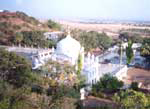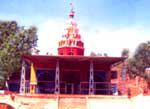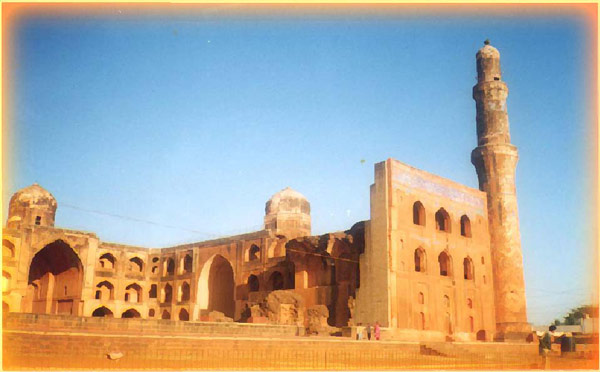Bidar
Bidar |
About: |
| Bidar is a city and taluka in Karnataka state, India. It is the administrative seat of Bidar District. Bidar is also known as Karnatakda kerita. Bidar city is known for its unique Bidri handicraft products. Manjeera is one of the main rivers supplying drinking water for Bidar and Hyderabad cities In the NorthBidar Fortern most part of Karnataka lies Bidar. As you enter, the imposing Bidar Fort welcomes you with its five Darwazas (doorways / gates) that lead into a town nestled within the ramparts. Bidar was the capital of the Bahamani kingdom and later of the Barid Shahi dynasty. It is also an important Sikh Pilgrim center. The historical fort of Bidar was a stronghold of the Bahamani Kings in the 14th and 15th centuries. The fort is surrounded by three miles of walls with 37 bastions, most of them surmounted with cannons. This fort was a source of irritation to the Mughal rulers of Delhi, and was finally conquered by Aurangazeb. The fort now lies in ruins. There is an Indian Air Force Station in Bidar, which was the Elementary Flying School (This has now been transferred to Secunderabad). |
Location info: |
| Address:Bidar is a city and taluka in Karnataka state, India. Bidar is located in the northeastern part of the state of Karnataka, in the southern region of India. It is 669 km from Bangalore and 136 km from Hyderabad. It is located 2,200 feet above sea level on a plateau overlooking the Manjira river valley. |
| District:Bidar |
| Nearest City:Bidar |
| Best time to visit: The best time to visit Bidar is between October and March. |
Climate/Weather: |
| The climate of Bidar is temperate with summers (April-June) being moderately hot and winters cool and pleasant (November-February). It experiences southwestern monsoon rains in the months of May to July. |
History: |
| In ancient time, Bidar formed an important part of the kingdom of Vidharba, referred to in the Mahabharata. It became the part of the Chalukyan Empire in the 10th century. The capital city of the Chalukyan rulers is located at Kalyani, which is 57 km from here. Bidar witnessed many upheavals during the early medieval period. It was taken over by the Yadavas of Devangiri and later by the Kakatiyas of Warangal in the 14th century. It then became a part of the Bahamani kingdom in the 14th century. The disintegration of the Bahamani kingdom into five small states led to the rise of the town and the Sultanate of Bidar. Sultan Ahmad Wali I shifted his capital from present-day Gulbarg to Bidar and built a fort here in 1429. The Bahamani rulers ruled here until 1487. The chequered history of Bidar did not stop here. The Barid Shahi dynasty took over Bidar, which was in turn taken over by the Adil Shahi rulers of Bijapur. It was annexed and incorporated into the Mughal Empire by Aurangzeb in 1656 while on his way to conquer the southern parts of India. The Nizam rulers of Hyderabad took over Bidar in the early part of the 18th century. After India gained independence in 1947, the rule of the Nizam was abolished and Bidar became the part of the Indian state of Karnataka.
Historically, Bidar was a part of the Bahamani Kingdom which comprised of Bijapur, Gulbarga, Bidar, Golconda, and Birar. The ruler of Bidar was Barid Shah. Bidar was later ruled by the Nizams of Hyderabad. Bidar witnessed the "religious revolution" under the Lingayat Reformist Basavanna. Basavakalyan from where Shaivism spread . Bidar boasts of several religious centers: The famous Nanak Jheera - the largest sikh temple atleast in Karnataka, carries the tale that Guru Nanak - the first guru of the Sikhs visited this place and got rid of the scarcity of drinking water in the region. A popular spot is the Sikh temple, Guru Nanak Jheera, where fresh crystal clear spring water appears from nowhere. To visit the Narasimha Jheera, you have to tread for atleast a furlong inside a cave with waist deep water ( and countless bats hanging from the roof!) to seek the a view of Lord Narasimha. Papanaash is a temple of Lord Shiva.....they say you can see snakes guarding the idol especially during Shivaraathri. |
Interesting things to do: |
| Bidar is famous for BIDRIWARE a distinct and exquisite inlay craft of this district. It involves embedding silver or gold into basic metal, mostly an alloy of zinc which forms a bluish-black background for the silver or gold. You can find elegant Bidriware objects like water goblets, jewellery cases, ashtrays and a host of other articles that would be ideal gifts from Karnataka.
FAIRS & FESTIVAL |
Interesting things to Visit: |
| The main tourist attraction of Bidar is its fort, which welcomes the tourist to the town, located within its precincts. Ahmad Wali Shah built this fort and the well laid out gardens and other monuments within it, in 1429. This fort has five imposing entrances or Darwazas. In the center of this fort is the old city with its monuments and structures, belonging to the Bahamani era. There are important palaces within the ramparts of the fort. The Rangin Mahal, once the royal abode, has ornately carved wooden pillars and Persian artwork. The Solah Kambh Masjid (16-pillared mosque) is the oldest Muslim building in Bidar, and one of the largest in India. The Gagan Mahal, the Diwan-e-Am, the Royal Pavilion, the Takhat Mahal are other important places to be seen within the fort. Of great importance for the visitor is the Mahmud Gawan Madarsa, which is in ruins but still has a few colorful remains of Islamic mosaic work on its walls. Surviving blue-glazed tiles and Q'uranic verses carved on the walls in flowing calligraphic style point to the erstwhile splendor of this building. The surrounding areas both west and east of the town are dotted with domed tombs of Bahamani and Barid Shahi rulers. These structures, though isolated, are captivating.
Pap Nash Temple: It is believed that Lord Sri Rama, on the way to Ayodhya from Lanka after defeating Ravana, visited this place and that resulted in the temple which would wash off his act of killing Ravana who is a Shiva Bhakt. Narasimha Zarna: The temple virtually runs into a cave waterbody and is one of the unique in the world. The water in the cave will guide the pilgrims to the idol. Madarasa: One of the oldest universities which was founded by Md. Gawan. |
Mobile range info: |
How to reach? |
| Nearest Railway Station:Bidar is connected by rail to Bangalore, Mumbai and Hyderabad. |
| Nearest Airport:The nearest airport is Hyderabad. |
| Road Transport:Bidar is 136 km from Hyderabad and 669 km from Bangalore. Buses ply from Bidar to Bangalore, Bijapur, Gulbarga, Raichur and Sholapur. |
Nearest Visiting places: |
| There are a few places of tourist interest around Bidar. Basvakalyan, the capital city of the latter Chalukyas in the 10th century, is 80 km from Bidar, while Humnabad, 52 km from Bidar, is a famous pilgrim center and attracts thousands of devotees annually. |
Nearest Petrol Pump: |
| Bidar |
Hotels/Lodge/Accommodation: |
| There are very few hotels and lodges in Bidar. Whatever accommodation is available is of mediocre standard. We offer excellent accommodation facilities in and around Bidar. |
Things to carry: |
Tips & Suggestions: |
| Bidar was not industrialized for a very long time and only recently, Bidar has seen the arrival of several induatrial centers. There is an Engineering college run by the Sikh trust in the town. Additionaly, there are several other educational institutions (managed by both Christian Missionaries and other communities). There is an Indian Air Force station in Bidar, which was the Elementary Flying School ( This has now been transferred to Secunderabad). The main occupation of the people here is agriculture. Sugarcane, Jowar and wheat are the main crops. One can take cycle-rickshaw or auto-rickshaw to move in the town. |
Help Line/Phone Number: |
| Police Station:Hyderabad |
| Nearest Hospital:Hyderabad |
| Society/Community Phone Number |
Bidar Nearest Attraction |
| Bidar Archeology |
| In 1424, the capital of Bahamini dynasty was transferred 116 km away to Bidar. Four other Muslim kingdoms of Bijapur, Golconda, Perar and Ahmednagar broke away from the Bhahamini kingdom. They called themselves five kingdoms but fought against each other.....more |

















